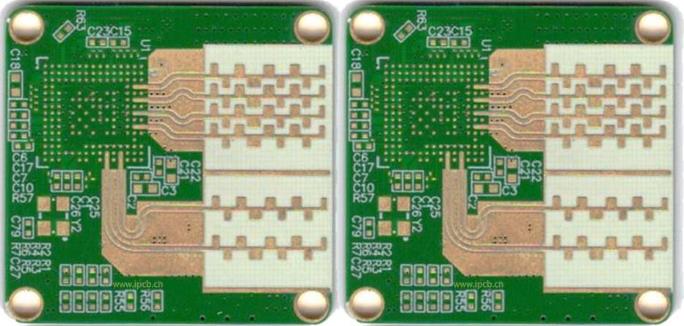Definition of PCB high frequency board
High-frequency board refers to special circuit boards with higher electromagnetic frequency, which are used in the field of high-frequency (frequency greater than 300MHz or wavelength less than 1 metre) and microwave (frequency greater than 3GHZ or wavelength less than 0.1 metre) PCBs, which are produced by using part of the manufacturing process of ordinary rigid circuit boards or adopting special treatment methods on the microwave substrate laminates. Generally speaking, high-frequency boards can be defined as circuit boards with frequencies above 1GHz.
With the rapid development of science and technology, more and more equipment design is in the microwave frequency band (> 1GHz) and even with millimetre wave field (30GHz) above the application, which also means that the frequency is getting higher and higher, the substrate of the circuit board requirements are also getting higher and higher. For example, the substrate data need to have excellent electrical performance, good chemical stability, with the new frequency of the power signal in the substrate loss requirements are very small, so the importance of high-frequency boards have come to the fore.
PCB high-frequency board application areas
1.Mobile communication products, intelligent lighting systems
2.Power amplifier, low noise amplifier, etc.
2.Power dividers, couplers, duplexers, filters and other passive components
2.Automotive anti-collision systems, satellite systems, radio systems and other fields, electronic equipment,high-frequency is the development trend.
Classification of PCB high-frequency boards
1.Powder ceramic filled thermosetting data
A. Manufacturer:
4350B/4003C from Rogers.
Arlon's 25N/25FR
Taconic's TLG series
B.Processing Method:
And epoxy resin / glass woven fabric (FR4) similar processing process, except that the plate is more brittle,easy to break the plate, drilling holes and Causeway plate when the life of the drill nozzle and Causeway cutter to be reduced by 20%.
2.PTFE (Polytetrafluoroethylene) Information
A: Manufacturers
1.Rogers' RO3000 series, RT series, TMM series.
2.Arlon's AD/AR Series, IsoClad Series, CuClad Series
3.Taconic's RF Series, TLX Series, TLY Series
4.F4B, F4BM, F4BK, TP-2
B: Processing Method
1.Cutting: Protective film must be retained for cutting to prevent scratches and indentations.
2.Drilling:
2.1 Use brand-new drilling nozzle (standard 130), one piece and one stack is the best, the pressure of the foot is 40psi.
2.2 Aluminium sheet as a cover plate, then use 1mm miamine gasket to tighten the PTFE plate.
2.3 After drilling, use an air gun to blow out the dust in the hole.
2.4 Use the most stable drilling machine, drilling parameters (basically, the smaller the hole, the faster the drilling speed, the smaller the chip load, the lower the return speed).
3. Hole treatment
Plasma treatment or sodium naphthalene activation treatment for hole metallisation.
4.PTH copper immersion
4.1 After micro-etching (the rate of micro-etching has been controlled by 20 micro inches),pull in the PTH from the de-oiled cylinder into the plate.
4.2 If necessary,then after the second PTH,just start from the expected cylinder into the plate
5.Solder Resist
5.1 Pre-treatment:Acid wash, no mechanical grinding.
5.2 Bake the board after pre-treatment (90℃, 30min), brush with green oil for curing.
5.3 Bake the board in three sections: one section at 80℃, 100℃ and 150℃ for 30mins each (if the substrate surface is found to be dumping oil, it can be reworked: wash off the green oil and re-activate the treatment).
6.Causeway
The white paper will be laid on the PTFE board line surface, and the top and bottom will be clamped with the FR-4 substrate board or phenolic backing board with the thickness of 1.0MM etched and de-coppered.
Causeway board after the board edge burrs need to be carefully scraped by hand to prevent damage to the substrate and copper surface, and then separated by a considerable size of sulphur-free paper, and visual inspection, to reduce burrs, focusing on the process of Causeway board de-shawing effect should be good.
Technological process
1.NPTH's PTFE board processing flow
Opening - Drilling - Dry film - Inspection - Etching - Etching inspection - Solder resist - Character element - Tin spraying - Forming - Testing - Final inspection - Packaging - Shipment.
2.PTH's PTFE plate processing flow
Open material - Drilling - Hole treatment (Plasma treatment or sodium naphthalene activation treatment) - Copper immersion - Sheet electrode - Dry film - Inspection - Pattern electrode - Etching - Etching - Soldermask - Character - Spraying - Moulding - Testing - Final inspection - Packaging - Shipment.
High Frequency Board Summary
Difficulties in processing high-frequency boards
1. Copper sinking: the hole wall is not easy to be coppered.
2.The control of the graph rotation, etching, line gap of the line width, and sand hole.
3. Green oil process: control of green oil adhesion and green oil blistering.
4. Strict control of board surface scratching in each process.

High Frequency Board